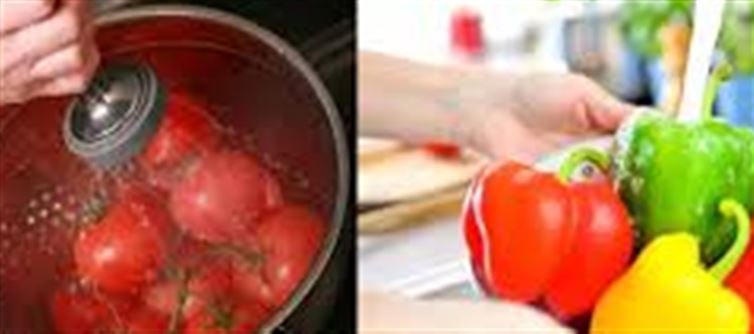
The monsoon season brings relief from the scorching heat, but it also creates the perfect environment for bacteria, fungi, and pesticides to thrive on fresh produce. Since fruits and vegetables are more prone to contamination during this time, washing them properly becomes essential to protect your family from foodborne illnesses.
Here are the 8 best ways to clean your fruits and vegetables during monsoon:
1. Rinse Thoroughly Under Running Water
The simplest and most effective first step is to wash fruits and vegetables under clean running water. Unlike soaking, running water helps remove dirt, mud, and pesticide residues more effectively. Use your hands to rub the surface gently.
👉 Best for: Apples, cucumbers, tomatoes, leafy greens.
2. Use a salt Water Solution
Soaking produce in a mild salt water solution (1 teaspoon of salt in 1 liter of water) for 10–15 minutes helps loosen dirt, kill small insects, and reduce pesticide residues. salt also helps dislodge wax coatings often found on store-bought fruits.
👉 Best for: Grapes, guavas, apples, spinach.
3. Wash with Vinegar Solution
Mix 1 part white vinegar with 3 parts water and soak your produce for 10 minutes. Vinegar’s natural acidity kills bacteria and reduces chemical residues. Rinse again with clean water to remove the vinegar taste.
👉 Best for: Berries, leafy greens, and grapes.
4. Use Baking Soda Soak
Baking soda (sodium bicarbonate) is excellent for removing pesticide residues. Add 1 teaspoon of baking soda to 1 liter of water and soak vegetables/fruits for 15 minutes, then rinse. Studies show it is one of the most effective methods to clean pesticide-coated produce.
👉 Best for: Apples, okra, brinjal, and cucumbers.
5. Peel or Scrub the Surface
For produce with tough skins, peeling the outer layer reduces exposure to pesticides and dirt. For others like cucumbers, carrots, and potatoes, use a vegetable brush to scrub under running water.
👉 Best for: Carrots, radish, cucumbers, potatoes, apples.
6. Use turmeric Water (Traditional Method)
Turmeric has natural antibacterial and antifungal properties. Adding a pinch of turmeric to a bowl of water and soaking vegetables for 10–15 minutes can help reduce microbial load. Rinse with clean water before cooking.
👉 Best for: Leafy greens, cauliflower, and beans.
7. Trim and Discard Outer Layers
Leafy vegetables like cabbage, lettuce, and spinach often trap dirt and microbes in their outer layers. Always remove and discard the outer leaves before washing.
👉 Best for: Cabbage, lettuce, spinach.
8. Dry Properly Before Storing
After washing, make sure to pat fruits and vegetables dry with a clean cotton towel or kitchen tissue. Storing them wet encourages fungal growth during humid monsoons. Keep them in breathable mesh bags or containers with ventilation.
👉 Best for: All types of produce.
🌟 Extra Tips for Monsoon Hygiene
- Buy fresh produce in smaller quantities to avoid long storage.
- Avoid cutting fruits in advance—moisture can make them spoil faster.
- Prefer seasonal and local vegetables, which are fresher and less treated with chemicals.
- Always wash hands before and after handling produce.
✅ Final Word
During the monsoon, food safety starts in your kitchen. By adopting these 8 effective washing techniques—ranging from simple rinsing to natural cleansers like salt, vinegar, and turmeric—you can keep your fruits and vegetables fresh, safe, and healthy for your family.
Disclaimer:
The views and opinions expressed in this article are those of the author and do not necessarily reflect the official policy or position of any agency, organization, employer, or company. All information provided is for general informational purposes only. While every effort has been made to ensure accuracy, we make no representations or warranties of any kind, express or implied, about the completeness, reliability, or suitability of the information contained herein. Readers are advised to verify facts and seek professional advice where necessary. Any reliance placed on such information is strictly at the reader’s own risk.
.jpg)




 click and follow Indiaherald WhatsApp channel
click and follow Indiaherald WhatsApp channel